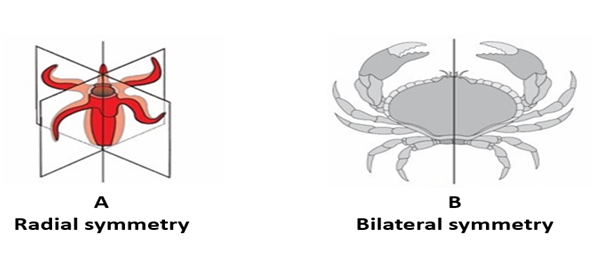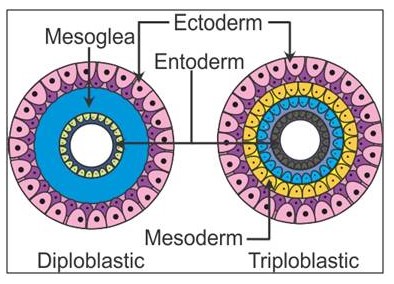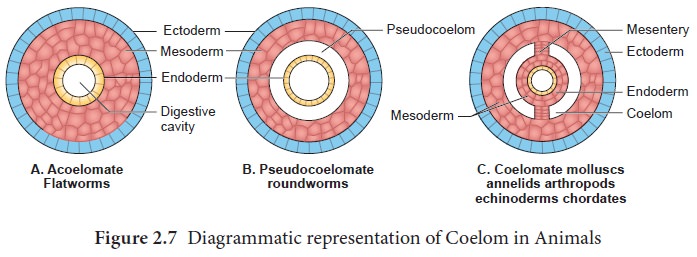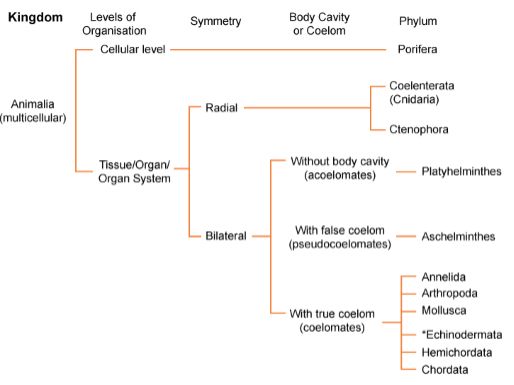Basis of classification in Animals
Despite differences in structure and shape across animals, there are essential similarities in cell organization, body symmetry, coelom type, and digestive, circulatory, and reproductive system patterns. These characteristics are used to classify animals, and some of them are covered here. The requirement for classification grows in importance as more than a million species of animals have been described to date. Newly described species can also be assigned a systematic position thanks to categorization.
A. Level of organization: Even though all members of Animalia are multicellular, they do not all have the same cell organization pattern. Sponge cells, for example, are grouped as loose cell aggregates, indicating that they have a cellular level of organization. Among the cells, there is some division of labour (activities). The cell arrangement in coelenterates is more complicated. The cells that perform the same function are grouped together ies, which is referred to as the tissue level of organization. Members of the Platyhelminthes and other higher phyla have an even higher degree of organization, namely the organ level, in which tissues are gathered together to form organs, each specialized for a certain function. Organs have come together to form functional systems in creatures including Annelids, Arthropods, Molluscs, Echinoderms, and Chordates.
B. Symmetry: The symmetry of animals can be used to classify them. Sponges are generally asymmetrical, which means that any plane passing through the centre split them in half evenly. Radial symmetry occurs when any plane traveling through the body's central axis divides the organism into two identical halves. This is the body plan of coelenterates, ctenophores, and echinoderms. Bilateral symmetry is found in animals such as annelids, arthropods, and others whose bodies can be divided into identical left and right halves in just one plane.

C. Germinal layers: During embryonic development, a germ layer is the first layer of cells that arises. Gastrulation is the process through which an early embryo develops three germ layers. Ectoderm, endoderm, and mesoderm are the three types of cellular layers that make up the body. Diploblastic creatures, such as coelenterates, have their cells organized in two embryonic layers, external ectoderm, and an internal endoderm. Between the ectoderm and the endoderm, there is an undifferentiated layer called mesoglea. Triploblastic animals are those in which the growing embryo has a third germinal layer, mesoderm, between the ectoderm and endoderm.

D.Coelom: When it comes to classification, the presence or absence of a cavity between the body wall and the gut wall is crucial. The coelom is the name for the bodily cavity that is lined by mesoderm. Coelomates are animals that have a coelom, such as annelids, mollusks, arthropods, echinoderms, hemichordates, and chordates. Mesoderm does not line the body cavity of some animals; instead, it appears as scattered pouches in between the ectoderm and endoderm. Pseudocoelom is the name for such a bodily cavity, and animals with them are known as pseudocoelomates, such as aschelminthes. Acoelomates, such as Platyhelminthes, are animals that do not have a body cavity.

E. Segmentation: The body of several animals is divided into segments both visibly and internally, with at least some organs repeating serially. The body of an earthworm, for example, displays a pattern known as metameric segmentation, and the phenomenon is known as metamerism.
F. Notochord: In some animals, the notochord is a mesodermally derived rod-like structure that forms on the dorsal side during embryonic development. Chordates are creatures that have a notochord, while non-chordates are animals that do not have one, such as Porifera and Echinoderms.
The broad classification of Animalia is based on common fundamentalfeatures as discussed above. A schematic diagram for the same is given below.


 ACME SMART PUBLICATION
ACME SMART PUBLICATION
